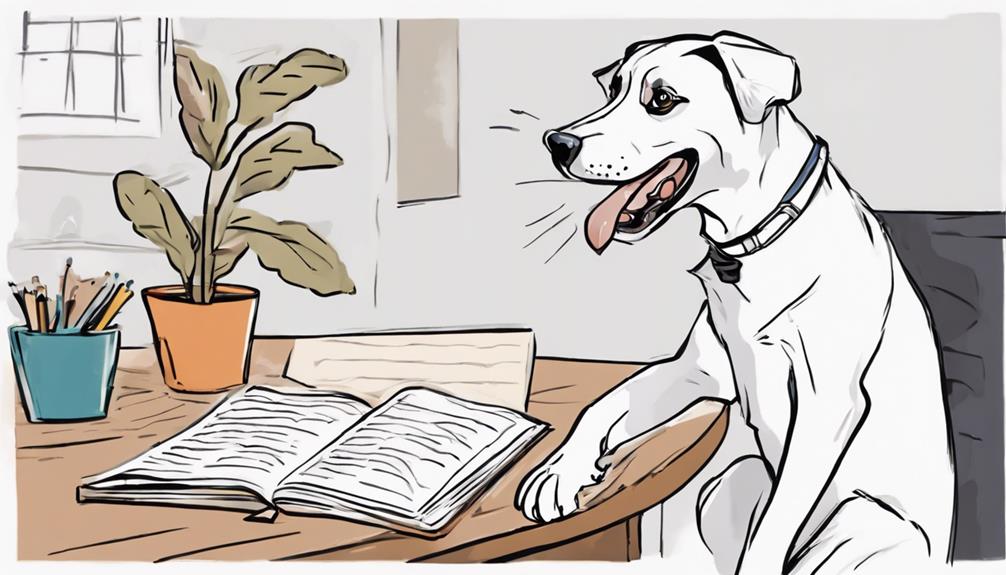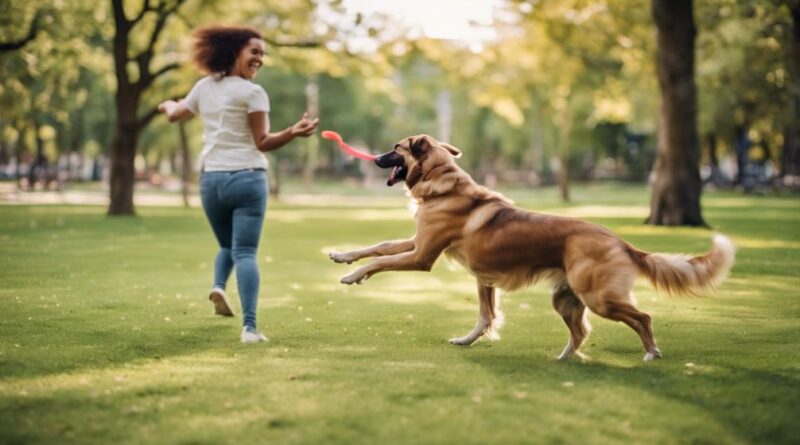13 Tips to Decode Your Dog's Love Language
Unlock the secret code to your furry friend's heart by deciphering their unique love language.
Ever felt like your dog is trying to tell you something more than just a wag of the tail? Understanding these subtle cues can strengthen the bond between you and your canine companion, leading to a more fulfilling relationship.
By learning to interpret their behaviors and responses, you can create a deeper connection based on mutual understanding and affection. But how exactly can you crack the code to your dog's emotional world?
Understanding Canine Body Language
To truly understand your dog's feelings and intentions, pay close attention to their body language. Posture analysis is key in deciphering what your furry friend is trying to communicate. A relaxed body, with weight evenly distributed on all four paws, indicates a calm and content state. On the other hand, a tense posture with raised hackles or a lowered body could signal fear or aggression.
Gesture interpretation is another crucial aspect of understanding your dog's emotions. A wagging tail, for example, is often associated with happiness and excitement. However, it's important to consider the context and other body cues alongside the tail wag to get a more accurate read on your dog's mood. Similarly, pawing at you might be a sign of affection or a request for attention.
Recognizing Tail Wagging Signs
Understanding your dog's tail wagging signs can provide valuable insights into their emotional state. Tail wagging meanings vary depending on the situation. A wagging tail doesn't always mean happiness; it's essential to consider the context. For example, a slow wag may indicate uncertainty or caution, while a fast wag often signifies excitement or joy. Reading wagging speed is crucial in interpreting your dog's feelings accurately. Additionally, pay attention to the position of the tail. A high tail usually indicates confidence or alertness, while a tucked tail suggests fear or submission.
When your dog wags their tail while meeting someone new, observe their body language for a better understanding of how they truly feel. Remember that tail wagging signs should be considered alongside other body signals to get a complete picture of your dog's emotional state. By recognizing these tail wagging cues, you can strengthen your bond with your furry friend and respond to their needs more effectively.
Interpreting Vocalizations and Sounds
When deciphering your dog's vocalizations and sounds, pay close attention to the pitch and tone they use to express their emotions. Dogs communicate a lot through their barks. Different types of barks can convey various messages, such as excitement, fear, or alerting you to something. Interpreting barking signals can give you insight into what your furry friend is trying to convey. For example, a rapid, high-pitched bark could indicate excitement or playfulness, while a deep, slow bark may signal a warning or potential threat.
Growling is another vocalization that dogs use to communicate. Understanding growling cues is essential for interpreting your dog's feelings. While growling is often associated with aggression, it can also signify fear, discomfort, or pain. Context is crucial when deciphering growls; pay attention to your dog's body language and the situation at hand to accurately interpret their vocalizations. By recognizing the nuances in your dog's barks and growls, you can better understand their emotions and strengthen your bond with them.
Decoding Facial Expressions
Pay attention to your dog's facial expressions as they provide valuable insights into their emotions and thoughts. Understanding your furry friend's non-verbal cues can help you strengthen your bond and ensure their well-being.
Here are some key points to consider when decoding your dog's facial expressions:
- Interpreting Ear Movements: Your dog's ears are like antennas that convey a lot about how they're feeling. When your dog's ears are perked up and facing forward, they're likely alert and interested. On the other hand, flattened ears might indicate fear or submission.
- Analyzing Eye Contact: Dogs use eye contact to communicate various emotions. A soft, gentle gaze often signifies affection and trust, while prolonged staring can be seen as a challenge or aggression. Understanding your dog's eye contact can help you respond appropriately to their needs.
- Overall Facial Expressions: Pay attention to the wrinkles on your dog's forehead, the tightness of their lips, and the position of their eyebrows. These subtle cues can reveal if your dog is happy, anxious, or stressed.
Bonding Through Eye Contact
Engage in meaningful eye contact with your dog to strengthen your bond and deepen your connection. When you look into your dog's eyes, you're creating an unspoken connection that can lead to silent conversations. Dogs are masters at reading human emotions, and through eye contact, they can understand your feelings and intentions. By maintaining eye contact with your furry friend, you're building trust and deepening bonds.
When you gaze into your dog's eyes, oxytocin, the 'love hormone,' is released in both of you, fostering feelings of love and affection. This mutual gaze triggers a positive emotional response, enhancing the bond between you and your canine companion. Through eye contact, you can communicate comfort, reassurance, and even establish dominance in a gentle manner.
Make it a habit to engage in eye contact with your dog during moments of affection, play, and training. Remember, the eyes are windows to the soul, and by connecting through them, you're strengthening your relationship in ways beyond words.
Importance of Physical Touch and Affection
Strengthening your bond with your dog involves recognizing the importance of physical touch and affection in nurturing your relationship. Your furry friend thrives on the love and care you provide through these gestures. To truly connect with your dog on a deeper level, consider the following key points:
- Consistent Cuddles: Regular hugs and cuddles can make your dog feel secure and loved, strengthening the emotional bond between you both.
- Gentle Petting: Dogs often enjoy gentle petting as it can be soothing and comforting for them, showing your affection and care in a way they understand.
- Playful Touch: Engage in interactive play that involves physical touch, such as belly rubs or back scratches, to create joyful moments and enhance your connection.
Observing Behavioral Changes

Noticing changes in your dog's behavior is crucial for understanding their needs and well-being. Paying attention to body language cues and changes in behavior can provide valuable insights into how your furry friend is feeling.
For example, if your usually energetic dog suddenly becomes withdrawn and uninterested in activities they typically enjoy, it could be a sign that something is bothering them. Similarly, if your dog starts displaying aggressive behavior towards people or other animals when they're usually friendly, it may indicate underlying stress or discomfort.
Keep an eye out for any sudden shifts in appetite, sleep patterns, or overall demeanor, as these could all be indicators of potential health issues or emotional distress. By observing these behavioral changes and addressing them promptly, you can better tailor your affection and care to meet your dog's specific needs, ensuring a happy and healthy relationship.
Tailoring Affection to Your Dog's Personality
Tailor your affection to your dog's unique personality by observing their preferences and responding accordingly. Understanding what makes your furry friend tick can deepen your bond and ensure they feel loved and appreciated. Here's how you can customize your approach:
- Personalized Training: Just like humans, dogs have different learning styles. Tailor your training methods to suit your dog's personality. Some may respond better to positive reinforcement, while others may require a firmer approach. Pay attention to what motivates your dog to achieve the best results.
- Customized Rewards: When it comes to rewarding good behavior, one size doesn't fit all. Some dogs may go crazy for treats, while others may prefer a favorite toy or extra playtime. Experiment with various rewards to see what truly makes your pup happy.
- Respect Their Boundaries: Not all dogs enjoy constant cuddles or belly rubs. Respect your dog's personal space and comfort levels. Some may prefer showing affection through playtime or quiet companionship. Learn to recognize and honor their boundaries for a harmonious relationship.
Frequently Asked Questions
How Can I Tell if My Dog Is Feeling Anxious or Stressed?
If your dog is feeling anxious or stressed, watch for behavioral cues like excessive panting or yawning. Physical signs such as trembling or hiding can also indicate their stress.
To help calm your pup, try using soothing techniques like gentle massages or providing a safe, quiet space.
Are There Specific Vocalizations or Sounds That Indicate My Dog Is Feeling Happy?
When your dog's happy, they might make joyful sounds like barks or yips. Tail wagging is another sign of their happiness.
But be cautious with growling; it can indicate excitement, not just aggression. Observe their body language to truly understand their emotions.
Can Dogs Show Affection Through Specific Body Language Gestures?
Dogs can definitely show affection through specific body language gestures. They might express their love by wagging their tail enthusiastically, giving you gentle nudges, or even licking you. Playful barks are also a sign of their affection.
Keep an eye out for these cues to understand how your furry friend is showing their love for you.
What Should I Do if My Dog's Behavior Suddenly Changes Without Any Apparent Reason?
If your dog's behavior suddenly changes without any apparent reason, it could be a sign of underlying issues. Behavioral changes might indicate medical problems, so it's crucial to consult a vet. Address any potential health concerns first.
If medical issues are ruled out, focus on training and consistency in your interactions. Keep an eye on your dog's behavior for any patterns and seek professional help if needed.
How Can I Determine the Best Ways to Show Affection That Align With My Dog's Unique Personality Traits?
To determine the best ways to show affection that align with your dog's unique personality traits, observe their preferences. Pay attention to how they respond to different gestures. Tail wagging can indicate happiness, but each dog is different.
Some may prefer belly rubs, while others enjoy playtime. Experiment with different ways of showing love and observe how your dog reacts to find the methods that resonate with their personality.
Conclusion
Now that you know how to decode your dog's love language, you can strengthen your bond and deepen your connection with your furry friend. By paying attention to their body language, tail wagging signs, vocalizations, facial expressions, and the importance of physical touch, you can better understand and communicate with your dog.
Remember to tailor your affection to their unique personality and always show them love in a way that resonates with them. Your dog will appreciate it and your relationship will flourish.
